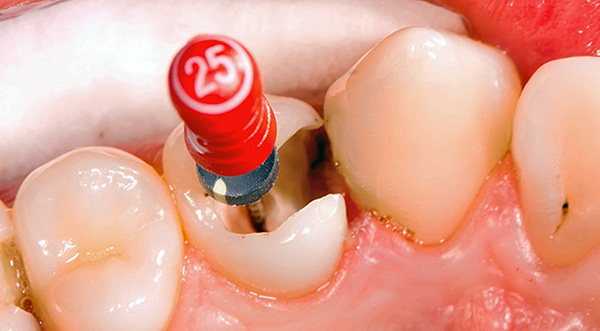
Often, after treating pulpitis, patients, to their surprise, find that the tooth continues to hurt - it hurts to press, bite, or it can even whine without any external influences. It would seem that there is still pain - after all, the nerve has been removed!
Unfortunately, post-filling pain after treatment of pulpitis is a frequent phenomenon, and the problem does not always go away on its own within a few days. Sometimes people are tormented for months before finally realizing that without medical help, excruciating soreness will not disappear on its own.
Let's see why such a problem can occur, what causes it usually cause and, most importantly, how to act in a given situation ...
Pain after treatment of pulpitis as a normal option
It should be understood that pulpitis treatment - The procedure itself is rather traumatic. Many specialists draw an analogy with surgical intervention, since the dentist first opens the tooth, and then removes natural soft tissues (inflamed or already necrotic neurovascular bundle) from the pulp chamber, and then replaces these tissues with artificial filling material (so that the tooth does not there were voids in which bacteria could multiply).
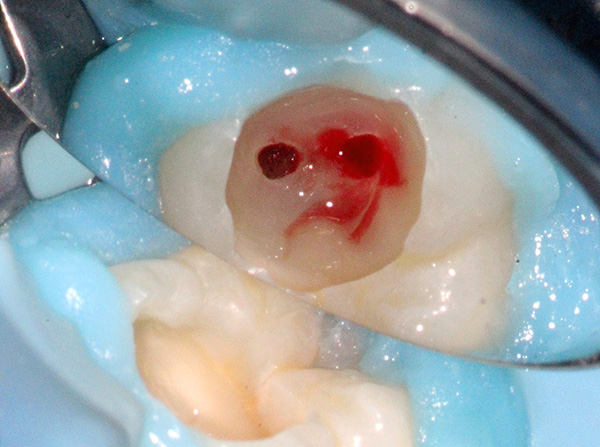
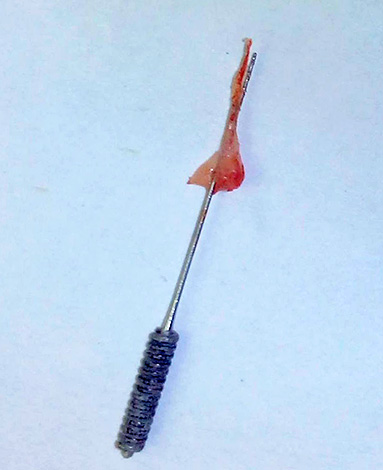
Since the roots of the teeth are quite long, the doctor uses special dental needles (the so-called files) - each needle has a specific length and thickness, and is designed to clean the tooth canals of the remnants of inflamed pulp. During operation, the needle is brought almost to the apex of the tooth root, and sometimes it is also pulled out of the tooth, injuring the soft tissues adjacent to the root.
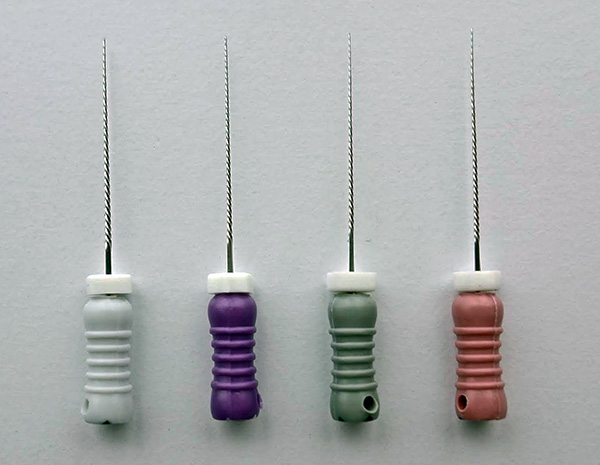
Read more about the procedure for removing the tooth "nerve" in a separate article: How to remove a nerve from a tooth and what problems may arise.
Also, a mandatory step in the treatment of pulpitis is the washing of the channels with fairly concentrated solutions of disinfectants, the classic of which is sodium hypochlorite solution.
All this is a kind of stress for the tissues surrounding the tooth, and restoration after an injury takes some time. Each case is individual, but on average, normal pain after treatment for pulpitis lasts no more than 5-7 days, subsiding day by day. All this time it really hurts to press on a tooth or bite on it during a meal. In addition, in the first days after treatment, body temperature may rise as a natural response of the body to local inflammation due to trauma.
Dentists' recommendations for this period are standard - use pain medication. However, often doctors do not say what to do to the patient, if the pain did not go away in a week and no improvement is observed.
Nuances that patients usually don’t talk about
If the tooth hurts for more than a week after treating pulpitis, this is a reason to beware. As with other doctors, certain errors can occur in the dentist’s work, leading to complications, and such errors can occasionally occur even with doctors with 30 years of experience.
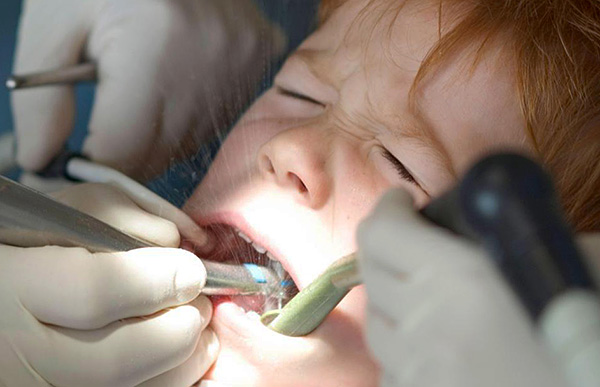
In order to better understand the essence of the possible causes of post-filling pains and the criticality of a particular situation for the further fate of the tooth, let's analyze the possible medical errors in more detail.
Overheating of tooth tissues
In most cases, the removal of carious tissues of the tooth, for example, against the background deep cariesIt is carried out with the help of mechanical rotating tools - hogs (sometimes with a laser). During this procedure, there is a strong heating of both the tool itself and the hard tissues of the tooth.
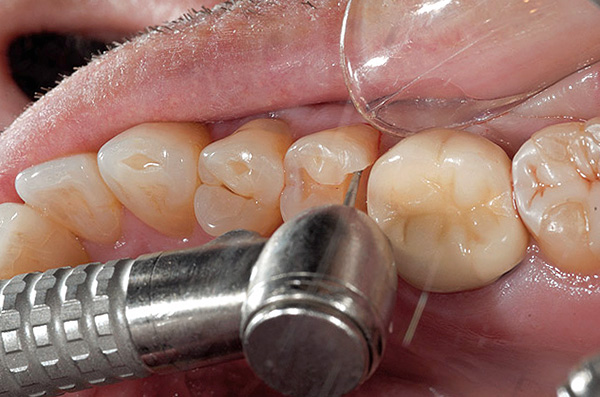
If during operation, sufficient cooling of the working area is not provided with water (fortunately, this rarely happens), then overheating of soft tissues adjacent to the tooth and their thermal burn may occur. Due to the action of anesthesia, the patient will not even feel this during treatment.
Depending on the severity of the burn, pain after treatment of pulpitis can pass on average from 7 to 14 days. For the further fate of the tooth, this is usually not critical.
The doctor did not cure all the channels of the tooth
With endodontic treatment, the doctor needs to create access to all root canals of the tooth - for this, you definitely need to find them all and open the mouth. For different people in the teeth with the same serial number, the number of channels may vary, and there may also be a different number of branches.
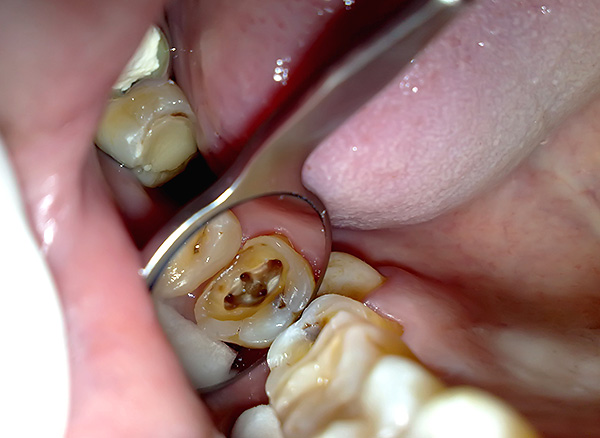
On a note
The anatomy of the root system of the tooth can be compared to a tree. In the roots of the teeth, the pulp fills special channels, and, as a rule, their number corresponds to the number of roots, but often there are additional channels.
The root canals have an estuarine part (beginning) communicating with the crown, and an apical part (on the final segment of the root), on which there is an anatomical opening - the apex through which communication with the surrounding tissues of the gums and jaw bone occurs.
So, it is unacceptable to leave at least one channel with the infection inside. It must be understood that in this case, the focus of inflammation will not go anywhere - it will remind of itself after the treatment of pulpitis, that is, the tooth will hurt. There may not be night pains, but it will painfully bite on a tooth for a long time, and the pathology can go into a chronic form with the formation cysts on the root of the tooth.
The photograph below shows a given tooth with a cyst on the root:
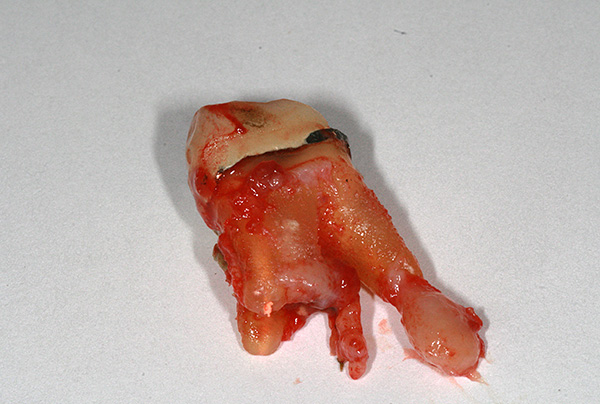
It is impossible to leave such a focus of infection without treatment, that is, in this case, the problem is critical for the further fate of the tooth. An untreated tooth canal left untouched will sooner or later force the patient to see a doctor again, and sometimes the only option is to remove the tooth amid exacerbation of periodontitis.
Chipping a tool in a channel
Breaking in the channel of a dental instrument (usually a piece of file breaks off) is one of the most unpleasant complications of treatment for both the doctor and the patient. Leaving the tool in the channel, if not removed, is fraught with an unfavorable forecast - tooth extraction over the next few years.
In addition, after treatment of pulpitis, the tooth can be sick for a long time - up to several weeks (although in some cases the pain can go away in normal terms, literally in a couple of days, but this does not mean there is no infection in the area of the broken instrument).
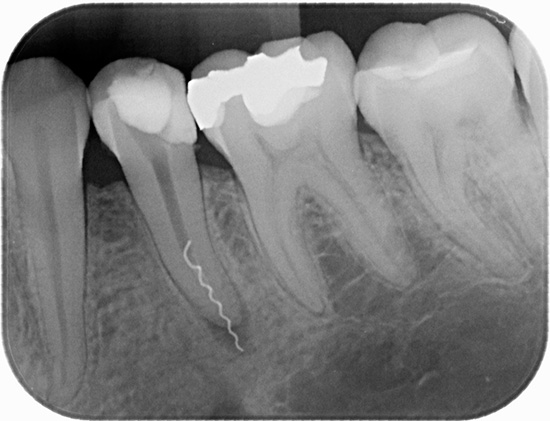
Why does the dental file used to clean the canals sometimes break? The most common reasons for this are:
- The application of excessive force when working with a file;
- Failure to comply with the principles of working with the tool - certain tilt angles of files;
- Too long work with an already deformed tool. Each file is designed for a certain number of manipulations, but sometimes doctors neglect this, not changing the file to a new one when processing the channel.
If the file broke at the very beginning of the processing of the channel, then this is not so scary, since the doctor can relatively easily remove the broken off part using special ultrasonic nozzles. If the file breaks closer to the end of the channel, then the chip can be very difficult to get.
On a note
The use of a dental microscope helps a lot with this work, but not all clinics have such equipment. Therefore, the doctor sometimes technically cannot extract a piece of the file from the channel, and is forced to fill it as is - that is, with a fragment inside the channel (not everyone is ready to admit his mistake, plus the inability to fix it,sending the patient to another clinic).
The following photo shows a tool chip extracted from the root canal:
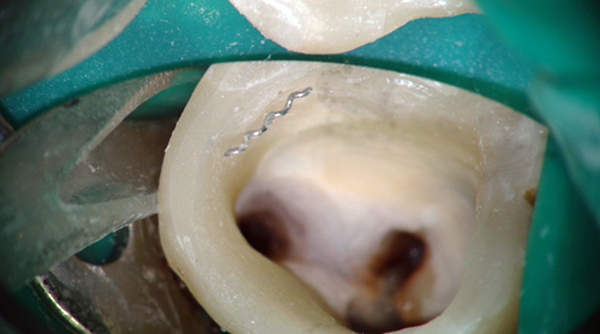
However, it is still necessary to get the chip, because the part of the tool remaining in the channel blocks a certain segment of the root and does not allow its processing to be completed - accordingly, an untreated infection focus is formed, which in the future can lead to tooth extraction.
The output of the filling material for the top of the tooth root
A modern and widely used material for filling canals is gutta-percha pins. They correspond to the marking of the files with which the channel is prepared, and fit on the length of the root, not quite reaching the anatomical opening of the outlet into the underlying tissue.
On a note
Gutta-percha is a natural resin, similar in chemical composition to the composition of natural rubber. Its molecular chain is longer, therefore it is less ductile than rubber. Widely used as a non-absorbable filler for root canal filling.
Another variant of the filling material is various paste-like cements, which harden inside the tooth canal after a short time.
In dentistry, bioinert materials are used, that is, it is assumed that they are harmless to the body. Nevertheless, if the filling material is taken outside the root, then it can cause inflammation of the surrounding tissues - like a splinter in the finger.
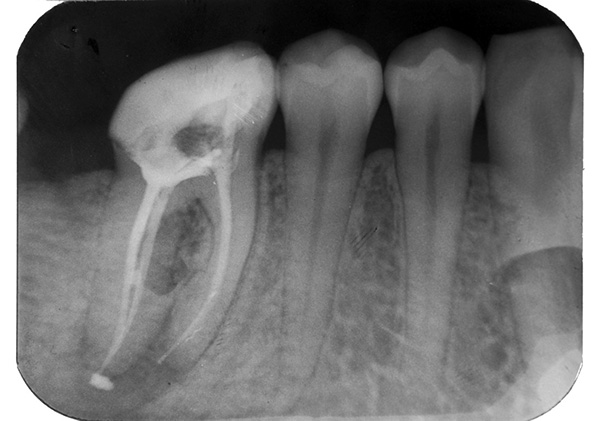
With excessive removal of filling material for apex, post-filling pains can be very long. Sometimes pain with pressure on the tooth can persist for months.
In such cases, the tooth must be treated, because if the error is not corrected, the problem may not completely disappear in six months (in addition, a cyst may form on the root).
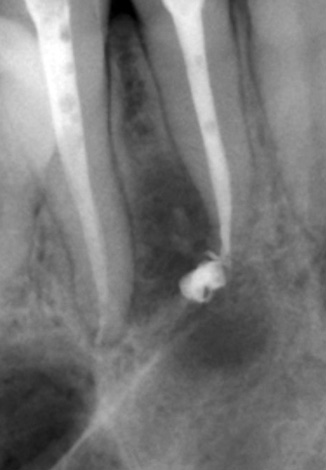
Feedback:
"Hello! Six months ago, she treated pulpitis, removed the nerve in the 12th tooth. When the anesthesia was gone, there was severe pain. The image shows the exit of filling beyond the root by about 2 mm. After a month and a half, the hells were sealed. The pain became a little less, but not to the extent that it could be tolerated.
Over the next 3 months, calcium was added and washed. The pain algorithm was as follows: when the procedure was performed and immediately after it there was severe pain for 7-10 days (it was impossible to eat, ate and drank through a tube, it was impossible to touch the tooth). Then the pain subsided a little, by 5-7 days, and then again intensified on an increasing basis. So 3 weeks pass, they wash me again, put calcium. All the same, in the same scenario.
Replaced the doctor. The new doctor decided for the fourth time to replace calcium and put another iodoform. 4 times less pain than during all these times of treatment. But it didn’t go completely - neither chewing nor biting was possible, that is, the pain still remained, but it could already be tolerated. In general, the tooth ache did not stop. And the doctor decided to put gutta-percha and a permanent seal anyway. Put. And as in the usual scenario: the first 7 days - it hurts very much, then less than a week, and then again the pain intensifies ... "
Olga, Moscow
And this is just one example from many cases when post-filling pains after treatment of pulpitis when removing the filling material at the root apex last for a very long time.
Tooth root fracture
Fracture of the root of the tooth is a rather rare and difficult to diagnose complication of endodontic treatment (it can not always be recognized on an ordinary x-ray). The root canals can be sealed according to all the rules, but sometimes during the work, a microcrack can occur at the root, which can only be seen on CT.
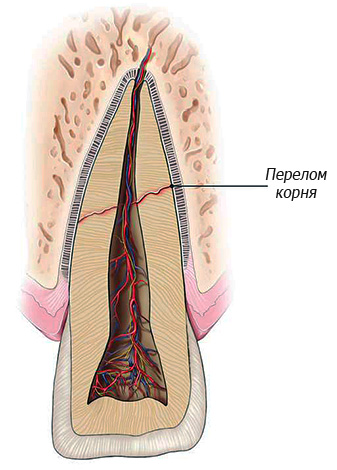
Fracture of the root of the tooth in most cases is an absolute indication for tooth extraction.
By the way, tooth root removal is far from a pleasant procedure.You can read more about it, as well as visually see certain moments in photographs, in this article.
In very rare cases, a root fracture can be cured using various techniques for fastening fragments to each other. But this is not always feasible.
The fracture does not grow together, and soft tissue inflammation soon forms around it. It is impossible to chew on such a tooth, the slightest load will cause severe pain.
After treatment of pulpitis, it is painful to bite on a tooth
In all the above cases, after treatment of the tooth canals, pain may occur when biting on the tooth, and sometimes it even feels like the whole side of the jaw hurts.
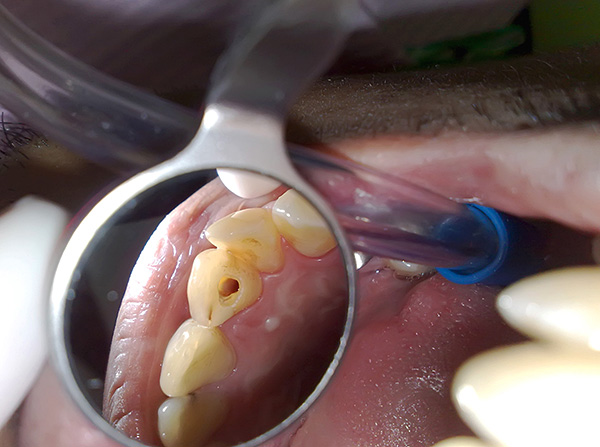
In rare cases, against the background of acute pain, a sensation may arise that the tooth began to move out of the gums. In dentistry, there is even a term - "the feeling of a grown tooth." A similar feeling occurs in patients due to periodontitis - a disease that is a complication of pulpitis (inflammation and suppuration of tissues adjacent to the root of the tooth occur).
If we talk about the acute phase of the disease, then the pain during chewing will be very strong, it can also "itch" and hurt the gums for a long length around the tooth. If the process is chronic, then these sensations will not be so pronounced. Periodontitis can develop in the absence of treatment for pulpitis, and also (in much more rare cases) - after improper treatment of pulpitis.
Overstatement of a seal - what will happen if nothing is done?
The dentition is very sensitive to any changes in it, therefore, even if the doctor treated pulpitis according to all the rules and with minimal damage to the tooth tissue, discomfort and even pain when biting due to a filling are possible for some time - first of all, it concerns fillings on chewing surface molars.
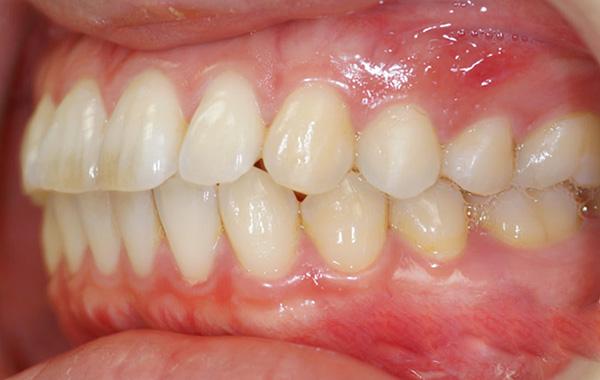
After treatment, the teeth sometimes close slightly differently, not quite as usual. The feeling of discomfort from a new filling can normally be from 5 to 7 days.
If the patient feels discomfort longer than this time, if the tooth interferes with the bite and there is a feeling that it is higher than the rest of the teeth, then without the intervention of a doctor this can lead to various problems - starting from loosening of the tooth itself (since it has an increased load) and ending with problems with the temporomandibular joint.
Here are some of the possible consequences of over-filling the bite, which sometimes occur over time:
- Difficult, painful opening of the mouth;
- Chewing pains (in some cases, pain may give in the ear);
- Clicking in the jaw joints when opening the mouth;
- Accelerated erasure of individual teeth;
- Regular headaches.
- A constant increased load on the tooth can also cause traumatic periodontitis.
On a note
In most clinics, dentists today use light-curing materials for dental fillings. This is due to their high strength, durability and aesthetics. Fillings from such materials do not erase during chewing for a very long time, so you should not expect that the seal will soon be erased and the problem will disappear by itself. Correctly remove excess fillings in height can only be a doctor with a drill.
After treatment of pulpitis, the cheek is swollen
It is important to understand that the swelling of the cheek that occurs after the treatment of pulpitis is a clear sign of inflammation of the soft tissues surrounding the tooth (and sometimes, in addition to the jaw bone). This condition can be accompanied by general malaise and weakness, a rise in body temperature, inability or difficulty in eating due to severe pain.
Normally, edema of the cheek after endodontic treatment is not observed at all. The temperature can really rise (up to 38-38.5 degrees), however, if severe edema is observed at the same time, fever and pain in the treated tooth is an alarming sign.
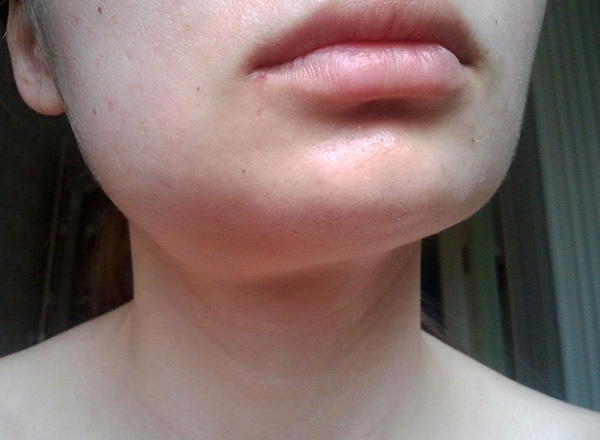
Such situations are quite dangerous, so you should not wait and waste time, believing that the swelling will resolve the next day and the temperature will pass.This may not happen, moreover, the situation can be significantly and rapidly aggravated (up to phlegmon - a deadly spilled purulent inflammation). Therefore, an immediate visit to a doctor, even for reinsurance and examination, will be the most correct decision.
In no case can a swollen cheek be warmed up, this will only worsen the condition. Also, you should not sleep on the side of the swollen cheek, so as not to aggravate edema.
If you notice a “pimple” (ulcer) or fistula on the gum, near the place where the pulpitis was treated, it can not be opened or cleaned by yourself. It is necessary to consult a doctor again and adjust the treatment (most likely, a focus of inflammation appeared on the root of the tooth, and pus paved its way into the oral cavity by melting the gum tissue).
As you can see, there can be many possible causes of tooth soreness after pulpitis treatment, and without additional examination it is usually difficult to say what exactly is the source of pain. If the pain persists for more than a week from the moment of treatment, or there is a significant swelling of the cheek, or other complaints that were not seen before going to the doctor, in such cases you need to go to a second appointment to clarify the situation.
Why does toothache after treatment of canals: comments of the dentist
Useful video about the appearance of toothache after tooth filling

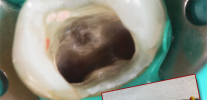
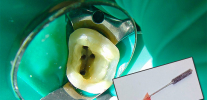
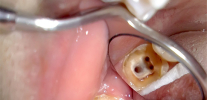
My tooth hurt terribly, I barely survived the weekend, no pills helped, the pain is terrible. First they put the medicine. Then a permanent seal. A month has passed after that. But biting is still painful. When should the pain go away?
Hello Maria. It can be stated that you already need to consult a specialist, since after 2 weeks the pain should have completely stopped. The situation you are describing is not normal. Perhaps there is an inflammatory process. Inspection and diagnosis are required, it makes no sense to endure pain further.
I had a tooth filled and now half is holding fine, and the other half is staggering. Not today or tomorrow it will break off. Immediately when the tooth was made, it was completely normal, and now I naturally have pulpitis. Is it possible to restore a tooth or have to pull out?
Hello, Alina. In order to answer your question, you need an examination, and only after that you can talk about choosing a treatment method. It is necessary to evaluate the line of fracture of the tooth - if it is chipped more than 3 mm under the gum, then, unfortunately, it will need to be removed. If the cleavage occurred at the gingival level, then a tooth-preserving operation can be performed to lengthen the crown of the tooth, and then restore the tooth using the orthopedic design (stump insert and crown) with the appropriate therapeutic preparation.
Good evening. 10 weeks ago my tooth ached. I went to the doctor - they removed the seal, killed the nerve, cleaned the canals, put calcium and put a temporary seal.This manipulation was performed 4 times every 2 weeks. The pain does not pass, I do not even chew on this side. I replaced the doctor and he did the same thing 2 times already ... Nothing has changed. Why does the pain go away?
Hello Anastasia. I assume that you are inaccurately diagnosed. I would recommend a diagnosis using CBCT (cone beam computed tomography). Perhaps in the tooth there is an additional channel that was not found (this happens) and, accordingly, was not processed, or there is a latent inflammation that could not be detected with a targeted image or using an orthopantomogram.
10/26/19 removed the nerve from the lower six, cleaned the canals and sealed. The next day there was a throbbing pain. The stronger the pressure on the tooth, the stronger the pulsating and the more painful. This is normal? And if not the whole nerve was removed, then now it is possible to have to be treated?
Hello Marat. If within the next few days there will be no positive dynamics, then in such a situation I would recommend CBCT to detect additional (not found) channels in the tooth or latent inflammation that was not detected on the targeted images or on the orthopantomogram. But usually the pain completely stops within a week after the endodontic treatment of the tooth.
Hello! Please tell me what to do. A week ago they put me a cement seal. After 3 days, a small piece from the edge broke off from it, I immediately felt the taste of cement in my mouth. A small gap appeared between the seal and the tooth itself. If you hold on the tooth, then there is a taste of cement. The doctor examined the whole thing and said that everything is ok, a little undermined. Is this really normal, or should I go to another clinic?
Hello, Ivan. First of all, I would recommend diagnosing the condition of the tooth with an independent dentist-therapist (especially if you have doubts about the actions of your doctor). If the connection of the filling with the tooth is not broken and its border is smooth, then this is normal. But if there is a gap between the filling and the tooth, it is better to replace the filling.